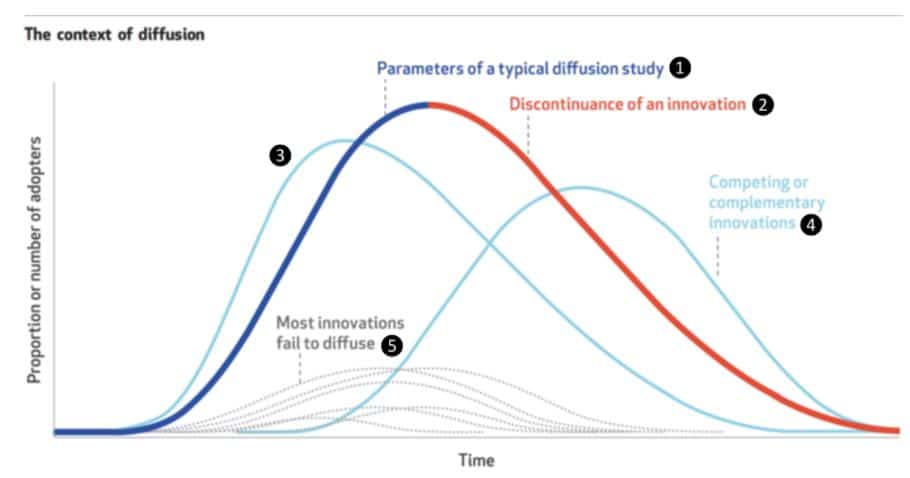by Amyn Amlani, PhD
The Diffusion of Innovation, developed by Rogers in 1962, is a social process that occurs among people in response to learning about an innovation. In this model, diffusion involves an innovation that is communicated through various channels, over time, to members of a social system. The reader was introduced to these concepts in Parts 1 and 2, respectively.
Context of Diffusion
When assessing diffusion, the dependent variable is time to adoption. Figure 1 below illustrates examples of the relationship between rate of adoption and how diffusion is characterized via hypothetical scenarios.
The multi-colored line displays the theoretical bell-shaped curve, with its initial slow rate of adoption that accelerates over time (denoted by blue line and indicated by 1 on the figure). This acceleration then slows—represented by the red line and denoted by 2 on the figure—as fewer nonadopters remain within the social system. The value of 3 represents a positively-skewed bell curve representing an early time to adoption, while the value of 4 signifies a time lag in the rate of innovation adoption. The final value—5—symbolizes the failure to diffuse as evidenced by the lack of adoption.

Figure 1: Examples of the relationship between rate of adoption and how diffusion is characterized via hypothetical scenarios.
Diffusion Among Specific Technologies
Figure 2 illustrates the diffusion of various technologies in time, adopted from Our World in Data. Technologies identified by the number 1 are those that have reached widespread diffusion or are trending towards widespread adoption. Note that only the Vacuum reached 100% adoption, while the Cellular Phone and Internet are trending > 85%. In addition, the Videocassette Recorder reached maturity in the early 2000s, but has since experienced a decline in its life cycle given advances in other technology areas.
Technologies—such as Smartphone Usage and Tablets—are trending positively as their product life cycles continue to grow and mature (i.e., represented by the number 2). Technologies represented by the number 3 are those that are experiencing resistance to adoption, potentially caused by alternative resources available in the marketplace.
Hearing aid data—taken from the various MarkeTrak studies—are also plotted as blue diamonds in Figure 2. Note the historically low adoption rate of this technology through MarkeTrak VIII—represented as the first four diamond symbols (i.e., data is shown for years 1984, 1990, 2000, and 2008)—and the recent increase to 34.1% in MarkeTrak 10. The interpretation of this technology sector requires us to wait patiently as new product acquisition and service delivery models are emerging. In a future segment, readers will be shown trends in market adoption as a data emerge as a function of consumer acquisition channels.

Figure 2: The diffusion of various technologies in time, adopted from Our World in Data.
What’s Next?
In the final segment of this series, the reader will be provided with content highlighting the hearing aid industry’s approach to crossing the chasm.






